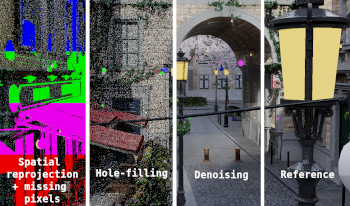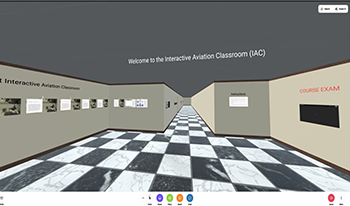
Spatial reprojection can be utilized to lower the computational complexity of stereoscopic path tracing and reach real-time requirements. However it adds dependencies in the pipeline. We perform the handling of data dependencies through a task scheduler framework that embeds workload and dependency information at each stage of the pipeline. We propose a novel image-parallel stereoscopic path tracing pipeline, parallelizing the spatial reprojection stage, the hole-filling stage and post-processing algorithms (denoising, tonemapping) to multiple GPUs. Distributing the workload of the spatial reprojection stage to each GPU allows to locally detect the holes in the images, which are caused by non-reprojected pixels. For the spatial reprojection, denoising and hole-filling stages, we have respectively a speedup of ×2.75, ×4.2 and ×2.89 per GPU on animated scenes. Overall, our pipeline shows a speedup of ×2.25 compared to the open source state-of-the-art path tracer Tauray which only parallelizes path tracing.

Aviation Maintenance Technicians (AMTs) play an important role in guaranteeing the safety, reliability, and readiness of aviation operations worldwide. Per Federal Aviation Administration (FAA) regulations, certified AMTs must document mechanic-related experience to maintain their certification. Currently, aviation maintenance training methods are centered around classroom instruction, printed manuals, videos, and on-the-job training. Due to the constantly evolving digital landscape, there is an opportunity to modernize the way AMTs are trained, remain current, and conduct on-the-job training. This research explores the implementation of Virtual Reality (VR) platforms as a method for enhancing the aviation training experience in the areas of aircraft maintenance and sustainability. One outcome of this research is the creation of a virtual training classroom module for aircraft maintenance, utilizing a web- based, open-source, immersive platform called Mozilla Hubs. While there is a general belief that VR enhances learning in general, very few controlled experiments have been conducted to show that this is the case. The goal of this research is to add to the general knowledge on the use of VR for training and specifically for aircraft maintenance training.